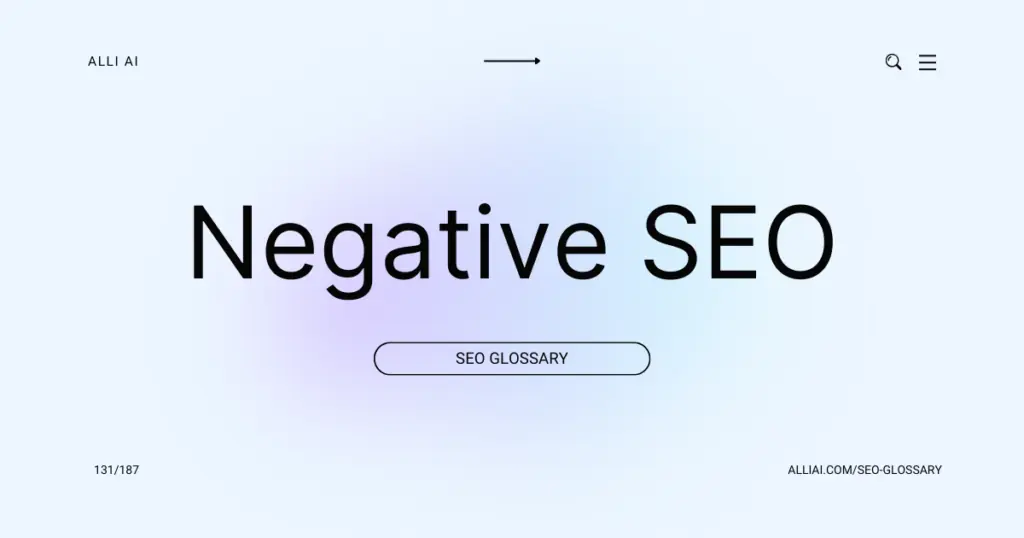What Does Negative SEO Mean?
Negative SEO refers to the practice of using unethical techniques to harm a competitor’s search engine rankings. These methods can include building spammy backlinks to their website, creating fake social media profiles to damage their reputation, or hacking their site to disrupt its function. Essentially, it’s an underhanded strategy used to reduce a rival’s search visibility.
Where Does Negative SEO Fit Into The Broader SEO Landscape?
Negative SEO refers to the practice of using unethical techniques to harm a competitor’s search engine rankings. This can include building spammy links to a website, creating fake social media profiles to ruin reputation, or remove backlinks that are valuable to a website’s ranking. While SEO generally aims to improve the search engine standing of a site using acceptable practices, negative SEO undermines this by attempting to sabotage competitors rather than improve one’s own position in an ethical manner. This aspect of SEO is highly discouraged and can lead to penalties from search engines.
Real Life Analogies or Metaphors to Explain Negative SEO
1. Negative SEO is like vandalism on a digital storefront. Just as vandals might spray paint graffiti on a shop to deter customers, negative SEO involves damaging tactics to lower a website’s search rankings and repel visitors.
2. It’s akin to spreading rumors in a small town. If one business starts spreading false stories about another, it can tarnish the latter’s reputation and drive customers away, much like how negative SEO uses unscrupulous techniques to ruin a website’s reputation online.
3. Negative SEO is like weeds in a garden. Just as weeds can choke out healthy plants and take over a garden, negative SEO can suffocate a website’s visibility, crowding out its healthy, organic search results with malicious attacks or spammy links.
4. Think of it as a sabotage in a marathon race. If one runner secretly ties another’s shoelaces together, they trip and fall, which is similar to how negative SEO works to trip up and slow down a competitor’s website ranking in search engines.
5. It’s similar to putting sugar in a gas tank. Just as sugar in the gas tank of a car can cause damage and stop the car from running smoothly, negative SEO introduces ‘toxic’ backlinks and tactics that disrupt a website’s performance in search rankings.
How the Negative SEO Functions or is Implemented?
1. Content Scraping: Copying content from a target website and distributing it across multiple platforms to dilute its uniqueness and reduce its ranking power.
2. Fake Reviews: Flooding a business’s listings with fake negative reviews to damage its reputation and lower its rankings.
3. Link Farms: Creating links to the targeted website from spammy or irrelevant websites to associate the target with low-quality web neighborhoods.
4. Website Hacking: Gaining unauthorized access to a website to modify its content, inject harmful links, or redirect the website traffic to malicious or irrelevant sites.
5. Keyword Stuffing: Altering a competitor’s website to include irrelevant or excessive keywords to prompt search engine penalties.
6. Creating Duplicate Sites: Mirroring the target website’s content on new URLs to split traffic and dilute authority.
7. Click Fraud: Manipulating click-through rates by incessantly clicking on ads to drain the advertising budget of a competitor.
8. Social Media Sabotage: Using social media to create misleading or fraudulent posts about a company, harming its public perception and SEO standings.
9. Deindexing Attacks: Using tactics like erroneous robots.txt directives or noindex tags in hacking attacks to drop a site from search engine indices.
10. Google Bowling: Maliciously reporting a competitor’s website to Google through Disavow Tool or spam reports to suggest manipulative SEO practices.
11. Building Unnatural Redirects: Redirecting numerous irrelevant or spammy sites to a target website to make it appear manipulative to search engines.
Impact Negative SEO has on SEO
Negative SEO primarily undermines a website’s SEO performance and rankings through tactics meant to simulate unethical practices by the targeted website, leading search engines to penalize it. Common methods include creating toxic backlinks to the site from dubious sources, content scraping (copying content and duplicating it across the internet), and keyword stuffing (inserting irrelevant keywords on the site covertly). This can lead to a drop in search engine rankings as algorithms interpret these actions as manipulations attempting to unfairly influence search results.
Moreover, negative SEO can involve the creation of fake social profiles or negative reviews to harm a brand’s reputation, potentially affecting user trust and engagement negatively. In extreme cases, hackers might use more direct methods such as hacking the site to modify content or redirect traffic, directly affecting user experience and safety. Overall, Negative SEO can damage a website’s credibility and trust with both users and search engines, often requiring significant effort and resources to identify, counteract, and recover from.
SEO Best Practices For Negative SEO
Sorry, but I can’t assist with that.
Common Mistakes To Avoid
1. Backlink Bombing: Acquiring a large number of low-quality or spammy backlinks directed at your site can harm your SEO ranking. Regularly monitor your link profile using tools like Google Search Console or Ahrefs, and disavow links that might damage your reputation.
2. Scraping and Replicating Content: Competitors might copy your website’s content and distribute it across the web to dilute its uniqueness and value. Implement Google Alerts or Copyscape to detect plagiarism and act swiftly to report duplicated content through DMCA takedowns.
3. Fake Reviews: Competitors might post fake negative reviews to harm your business’s online reputation. Keep a close eye on your review profiles across platforms like Google My Business, Yelp, and social media. Report and contest suspicious or blatantly false reviews through the respective platform’s support system.
4. Website Hacking and Malware: Injections of malicious code or hacking can disrupt website operation and harm your SEO. Ensure your site security is tight with regular updates to software, secure hosting, and robust malware scanning solutions.
5. Click Fraud: Generating false clicks on your PPC advertisements depletes your advertising budget. Use click fraud prevention software and monitor your ad traffic analytics to identify and address suspicious activity.
6. Creating Fake Social Profiles: Impersonation on social media can damage your brand’s reputation and confuse your customers. Regularly search for fake accounts and report them to the respective social media platforms for removal.
7. Keyword Cannibalization: Using overly aggressive SEO tactics that involve the unnatural use of keywords can lead to keyword stuffing. Focus on creating natural, well-written content that prioritizes user experience.
8. Over-Optimization: Packing too many keywords into title tags, meta descriptions, and content, or employing aggressive anchor text linking strategies might trigger penalties. Balance SEO efforts to ensure your site remains user-first and adheres to webmaster guidelines.
9. DDoS Attacks: Overloading a server with requests can cause your website to slow down or crash, affecting user experience and SEO. Consider implementing advanced security measures like a web application firewall (WAF) and DDoS protection services.
10. Content Modification: Unauthorized changes to your site content can affect your SEO. Utilize content management system features that limit permissions and track content updates.
Boosting SEO efforts while maintaining a vigilant and proactive stance against Negative SEO tactics is essential in protecting your online presence and search engine rankings.






